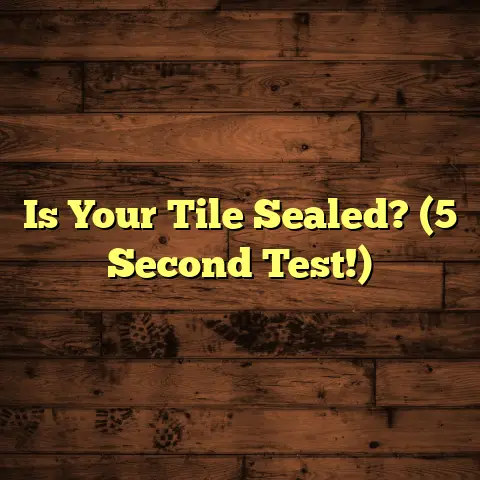Kilz On Concrete Floors? (6 Things To Know Now!)
I’m Mike, a flooring contractor for over 20 years.
I’ve seen it all when it comes to concrete floors.
And one question that keeps popping up is: “Can I use Kilz on my concrete floor?”
There’s a common misconception out there that Kilz is only for drywall or interior walls.
Many homeowners overlook its potential benefits and appropriate applications on concrete floors.
So, let’s dive deep and bust some myths, shall we?
I’ll share my experiences and insights on Kilz.
We’ll talk about how it works, when to use it, and how to avoid common pitfalls.
Ready? Let’s get started!
Section 1: Understanding Kilz – What Is It?
Okay, so what exactly is Kilz?
Kilz is a brand of primers and paints known for their stain-blocking, odor-sealing, and mildew-resistant properties.
Think of it as a superhero for your surfaces, fighting off stains and smells!
But not all Kilz products are created equal.
Some are better suited for concrete than others.
Kilz Original: This is the OG, the one that started it all.
Oil-based, it’s a heavy-duty stain blocker.
But honestly, I rarely use it on concrete due to its strong odor and longer drying time.Kilz Premium: This is my go-to for most concrete floor applications.
It’s water-based, low-VOC, and offers excellent adhesion.
Plus, it’s easier to clean up!Kilz 2: A step down from Premium, Kilz 2 is more of an all-purpose primer.
It’s okay for light stains, but I wouldn’t rely on it for serious issues on concrete.
So, why are some Kilz products better for
concrete?
It all comes down to the formulation.
Water-based primers, like Kilz Premium, tend to adhere better to concrete surfaces.
They penetrate the porous material more effectively than oil-based primers.
This creates a stronger bond and reduces the risk of peeling or bubbling later on.
Section 2: The Importance of Surface Preparation
Listen up, because this is crucial.
Surface preparation is the key to success when applying Kilz (or any coating) to concrete.
I can’t stress this enough: Don’t skip this step!
Here’s what you need to do:
Cleaning: Start by thoroughly cleaning the concrete floor.
I recommend using a concrete cleaner and a scrub brush.Remove all dirt, grease, oil, and any loose debris.
You might even need a pressure washer for stubborn stains.Repairing Cracks: Concrete cracks are like open invitations to moisture and other problems.
Use a concrete crack filler to patch up any cracks or holes.
Let it dry completely before moving on.Ensuring Dryness: This is where a lot of people mess up.
Concrete is porous, and it can hold a lot of moisture.Before applying Kilz, make sure the concrete is completely dry.
I recommend using a moisture meter to check the moisture level.Ideally, you want it to be below 4%.
If it’s higher, wait a few days or use a dehumidifier to dry it out.
What are some common mistakes?
Not cleaning thoroughly: If you leave dirt or grease on the surface, the Kilz won’t adhere properly.
It’ll peel or bubble down the road.-
Ignoring cracks: Cracks will continue to expand and cause problems. Filling them is essential.
Applying to damp concrete: This is a recipe for disaster.
The Kilz will trap moisture, leading to mold growth and adhesion issues.
Assessing the concrete’s condition is also critical.
Is it old and crumbling?
Is it heavily stained?
These factors will influence which Kilz product you choose and how many coats you apply.
Section 3: When to Use Kilz on Concrete Floors
Okay, so when should you use Kilz on concrete?
Here are a few scenarios where it can be a lifesaver:
Covering Stains: Concrete is notorious for staining.
Oil spills, rust, water damage – you name it.Kilz is excellent at blocking these stains from bleeding through your topcoat of paint or epoxy.
-
Sealing Odors: Musty basements, pet odors, or even previous chemical spills can linger in concrete.
Kilz can seal in these odors, creating a fresher and more pleasant environment.
-
Preparing for a Topcoat: Kilz acts as a primer, creating a smooth and uniform surface for your final coat of paint or epoxy.
This improves adhesion and ensures a more professional-looking finish.
Basements and garages are prime candidates for Kilz treatment.
These areas are often prone to moisture issues, making Kilz’s mildew-resistant properties particularly valuable.
I once had a client with a basement that smelled terrible due to previous water damage.
We cleaned the floor, applied two coats of Kilz Premium, and then topped it with an epoxy coating.
The result? No more smell, and a beautiful, durable floor!
Section 4: Application Techniques for Best Results
Alright, let’s get down to the nitty-gritty: how to apply Kilz to concrete like a pro.
Here’s my step-by-step guide:
-
Gather Your Tools: You’ll need:
- Kilz primer (I recommend Kilz Premium)
- Paint roller with a 3/8″ nap (for smooth concrete) or a 1/2″ nap (for rough concrete)
- Paint tray
- Paint brush (for edges and corners)
- Painter’s tape (to protect walls and trim)
- Safety glasses and gloves
-
Prepare the Area: Tape off any areas you don’t want to paint, like walls or trim.
Make sure the room is well-ventilated.
Apply the First Coat: Pour some Kilz into the paint tray.
Dip the roller into the tray, making sure to coat it evenly.Start in one corner of the room and roll the Kilz onto the concrete in a “W” pattern.
This helps to ensure even coverage.
Use the brush to get into edges and corners.Let it Dry: Allow the first coat of Kilz to dry completely.
Check the manufacturer’s instructions for drying times, but typically it’s around 2-4 hours.-
Apply a Second Coat (if needed): For heavily stained or porous concrete, a second coat of Kilz is recommended.
Repeat the application process from step 3.
-
Clean Up: Once the Kilz is dry, remove the painter’s tape and clean your tools with soap and water.
Choosing the right roller is important.
A 3/8″ nap
roller is best for smooth concrete, while a 1/2″ nap
roller is better for rough or textured concrete.
The goal is to achieve an even coat of Kilz without leaving any streaks or puddles.
Drying times can vary depending on temperature and humidity.
Higher humidity will slow down the drying process.
Make sure to provide adequate ventilation to speed things up.
I always tell my clients to err on the side of caution and wait longer than the recommended drying time before applying a topcoat.
Section 5: Potential Issues and Solutions
Okay, let’s talk about potential problems.
Even with the best preparation and application,
things can sometimes go wrong.
Here are some common issues I’ve seen:
-
Peeling: This usually happens when the Kilz doesn’t adhere properly to the concrete.
The culprit is often poor surface preparation.
Solution: Scrape off the peeling Kilz, clean the surface thoroughly, and reapply the Kilz.
Make sure to follow the surface preparation steps I outlined earlier.
-
Bubbling: Bubbles can form if moisture is trapped underneath the Kilz.
Solution: Puncture the bubbles, let the moisture escape, and then patch the area with more Kilz.
Again, make sure the concrete is completely dry before applying.
Improper Adhesion: This can happen if the concrete is too smooth or if there’s a contaminant on the surface.
Solution: Etch the concrete with a concrete etching solution to create a rougher surface.
This will improve adhesion.
Also, make sure to clean the surface thoroughly.
Following manufacturer instructions is crucial.
Don’t try to cut corners or deviate from the recommended practices.
I once had a client who didn’t bother to read the instructions and applied Kilz to a wet floor.
Needless to say, it was a disaster.
The Kilz peeled off within a few weeks.
Section 6: Long-Term Maintenance and Care
So, you’ve applied Kilz to your concrete floor. Now what?
Long-term maintenance is essential to prolong the life of your finish.
Here are some tips:
Regular Cleaning: Sweep or vacuum the floor regularly to remove dirt and debris.
Mop with a mild detergent and water.
Avoid using harsh chemicals or abrasive cleaners.-
Protect from Scratches: Place mats or rugs in high-traffic areas to protect the floor from scratches.
Use furniture pads under chairs and tables.
-
Address Spills Immediately: Wipe up spills as soon as they happen to prevent staining.
Environmental factors can also impact the longevity of Kilz on concrete.
High humidity can promote mold growth, while extreme temperature fluctuations can cause the concrete to expand and contract, leading to cracks.
To mitigate these effects, make sure to control the humidity in your basement or garage.
Use a dehumidifier if necessary.
Also, consider sealing the concrete with a clear sealer after applying the Kilz.
This will provide an extra layer of protection.
When should you reapply Kilz?
It depends on the
wear and tear of the floor.
If you notice peeling, bubbling, or staining, it’s time for a touch-up.
In some cases, you might need to strip the old Kilz and start from scratch.
Conclusion
So, there you have it!
Kilz can be a great
solution for concrete floors, but only if you do it right.
Don’t let the misconceptions fool you.
With proper surface preparation, the right application techniques, and regular maintenance, Kilz can transform your concrete floors.
Whether you’re tackling stains, sealing odors, or preparing for a topcoat, Kilz can help you achieve a professional-looking finish.
Now, go forth and conquer your concrete floors!
And if you’re feeling overwhelmed, don’t hesitate
to seek professional advice.
Good luck, and happy flooring!





